Diseases and pests of juniper: symptoms, causes, methods of struggle
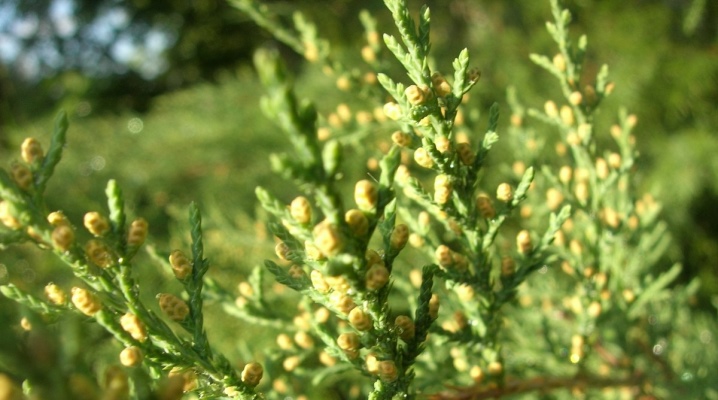
Juniper is sick, like other crops, and the cause of this is parasitic pests and fungal organisms. Every gardener needs to know what is the best way to deal with insects and diseases that can cause irreparable harm to the health of the plant.
Major diseases
Juniper diseases are fungal infections that develop as a result of improper care of the plant. The unpleasant thing is that each of them can cause the death of a culture.
Infection with the pathogenic fungus Alternariatenus Nees (Alternariosis) can lead to shedding of needles, but at first the crown of the juniper becomes dirty brown and is covered with a thin coating of black. You can advise cutting off the branches of a diseased plant and disinfecting the cut sites with garden pitch. The drugs that are effective in this case are copper oxychloride, "Abiga-Peak".
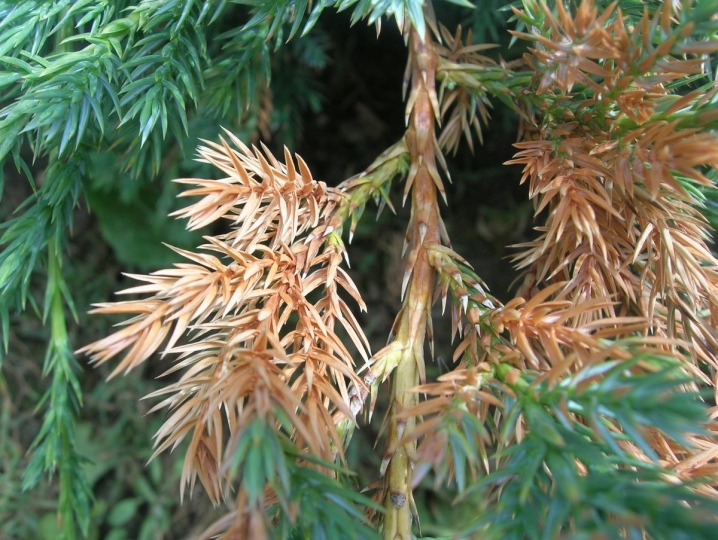
If in early spring the needles are yellow and covered with a white coating like a cobweb, then we can talk about such a sore as a brown shute.
In this case, the infectious agent is parasitic mushroom Herpotrichia nigra... Its fruits appear on the branches - black spherical influxes. The juniper needles die, but they remain on the branches, supported by the mycelium. The most effective method of control is pruning the shoots or eliminating the entire plant, followed by disinfection of the soil.
Cancer lesions of the culture are accompanied by a change in the color of the bark, its drying and cracking, which ultimately leads to the death of the plant. With non-turbo drying, brick-colored balls appear on the trunk and branches. The factors influencing the appearance of the disease are mechanical injuries of the juniper and a strong thickening of the plantings. "Fitosporin" and Bordeaux mixture as a preventive measure will help prevent the problem. With a large accumulation of neoplasms and transformation of the structure of the bark, it is necessary to get rid of the plant.
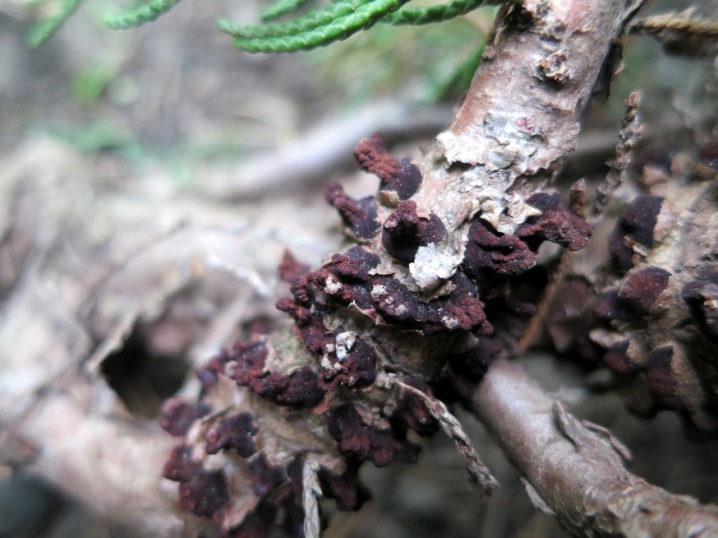
Different types of disease-causing fungi can cause branches to dry out. - if the bark of a tree or shrub is damaged, then the pathogen enters the inner part of the plant. This entails falling of the needles, yellowing of the needles, dying off of the bark and the appearance of black fruiting bodies of the fungus, even though the shoot is dry. Treatment consists of pruning, fungicide treatment and Bordeaux mixture.
Soil fungi, in turn, infect the roots and crown of the juniper from below. It is intuitively clear that fungicidal treatment should cover not only branches and needles, but above all the soil.
Pests and ways to combat them
Fortunately, the juniper crop doesn't have as many enemies as other conifers, including pine. The most common and dangerous organisms are presented below.
- The scale insect infects any type of juniper. Yellow-orange larvae settle on all parts of the crown, feed on plant sap, which slows down growth and development, and the bark dies off. The shield reduces the immunity of the plant, which entails infection with a fungal infection, after which additional treatment with fungicides is required. It is possible to save the culture with the help of systemic insecticidal agents, treating the crown and the ground 2-3 times at intervals of 2 weeks. It is better to alternate preparations due to the addiction of pests to active substances.
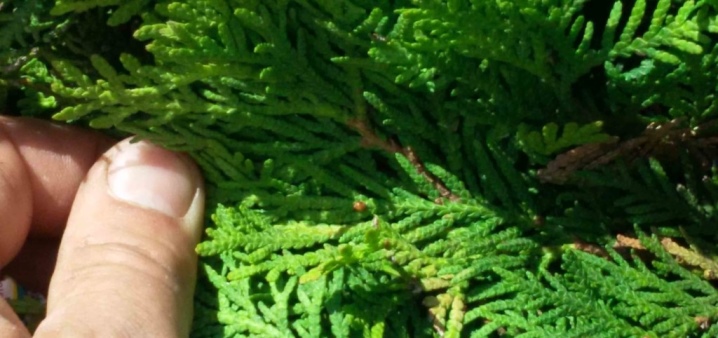
- Juniper aphid, which also feeds on plant juices, is dangerous for any variety. Since its larvae can be carried by ants feeding on honeydew secreted by an insect, it is necessary to start the fight by destroying ant nests. Spraying the crown with a solution of soap (250 g of detergent for 5 liters of water) will help to eliminate the pest, but also drugs such as Decis, Calypso, Mospilan, Rogor, contact insecticide Anabazin sulfate.
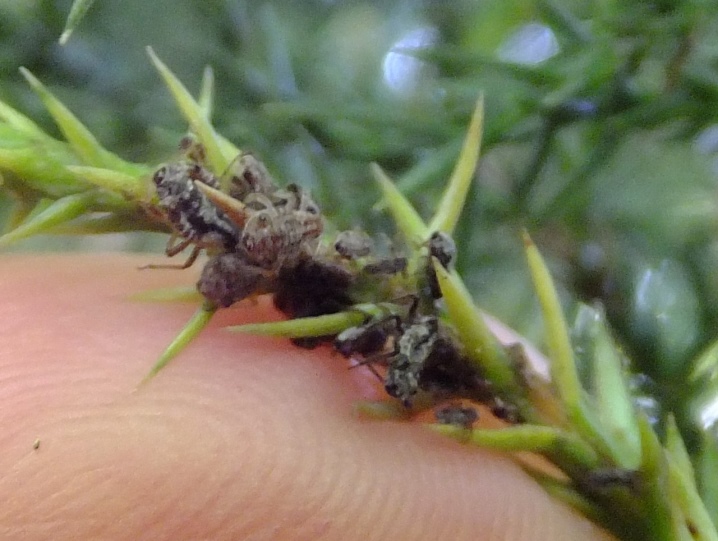
- Due to the settlement of gall midges - tiny mosquitoes, growths are formed on the branches surrounding the larvae. The pest feeds on these neoplasms. With many such balls, the only way out is to cut and burn the affected branches. In this case, the tree should be treated with "Aktellik", "Intavir", "Fufanon".
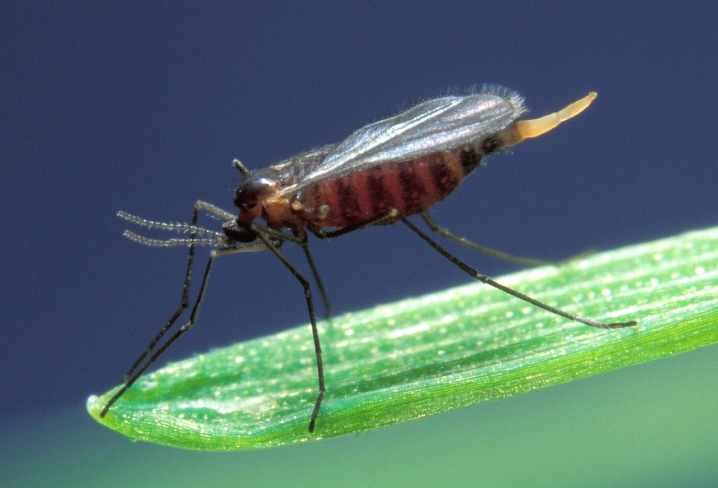
- The larvae of the juniper and coniferous sawfly living in the ground eat not only the needles, but also the inner parts of the plant. You can fight the pest manually, regularly dig up the soil, use adhesive tapes and exterminate the nests. However, spraying with insecticidal compositions - "Kinmiks", "Karbofos", "Bi-58" is more effective.
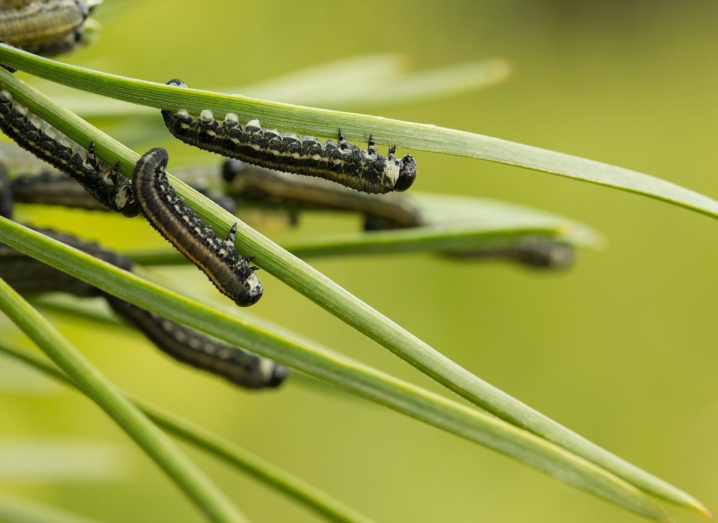
- On summer and autumn days, the juniper can be attacked by lepidoptera moths that devour needles. In a drought, they reproduce especially actively, and urgent measures must be taken to destroy them so that in the fall the caterpillars do not hide in the ground - there they will overwinter, and next year they will again begin to feed on the plant. You can understand that this is a moth by the spoiled needles - they show damage. As a treatment, pesticides of narrowly targeted action (against larvae) are used. Young branches are processed in early spring; it is also important to dig up the near-trunk ground.
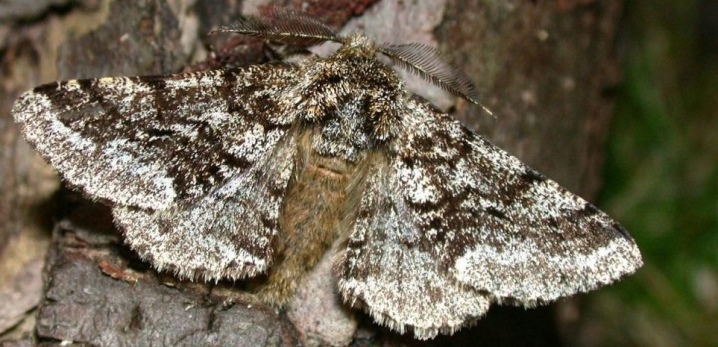
- In the event of an attack by a flat-calf mite, it is not always possible to reanimate the plant. The insect settles under the dead particles of the needles and in the wrinkles of the bark, so it is difficult to notice it. As a result of its vital activity, the foliage becomes discolored and crumbles, the juniper loses its healthy and attractive appearance, and often dies. Method of struggle: 3-fold treatment with drugs "Aktellik", "Nurel-D", "Caesar"; held with pauses of 10 days.
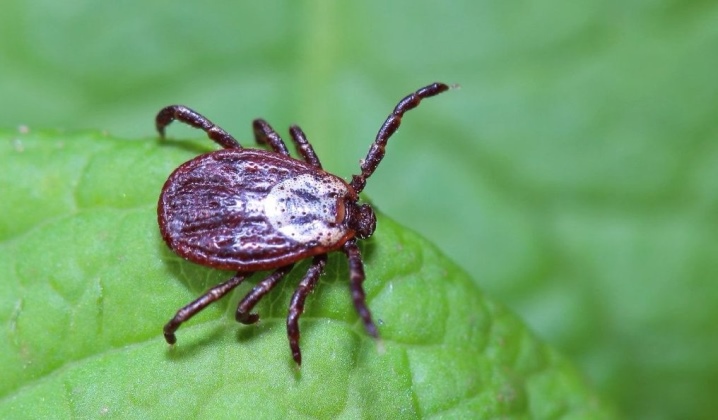
Meanwhile, harmful insects, as a rule, settle on damaged and weak plants, so that with good care, it is quite enough to carry out preventive procedures that prevent their appearance.
Why does it turn yellow and what to do?
Drying and yellowing of the needles on a juniper can have three main reasons. The most natural explanation for why the juniper crown dries up is when it burns during the winter months and early spring. Sunburns are associated with increased activity of the celestial body in some regions. Because of this, the processes of photosynthesis take place in the needles, but the roots are not yet able to fulfill their functions of providing the plant with moisture, and it becomes dehydrated. This results in a yellow color and shedding.
This situation can be avoided by covering the juniper from ultraviolet rays with burlap, until the end of March or the beginning of April. It is also advisable to thaw the ground at the roots, remove snow and irrigate with warm water so that the ground warms up. If the root system works, the plant will not lack moisture.
In addition, experts advise tying tree varieties so that the fragility of the branches arising from the weight of the snow does not subsequently cause dryness of the needles.

From creeping and ground cover plants, the snow mass will need to be shaken off regularly.
Juniper diseases can cause yellowing.
- Damage by soil fungi. Getting on the roots, the pathogen impairs their viability, since it interferes with the normal supply of nutrients in the soil. This disease is called "fusarium", and most often young shoots suffer from it.The defeat is directly related to waterlogging, lack of natural light and clay composition of the soil.
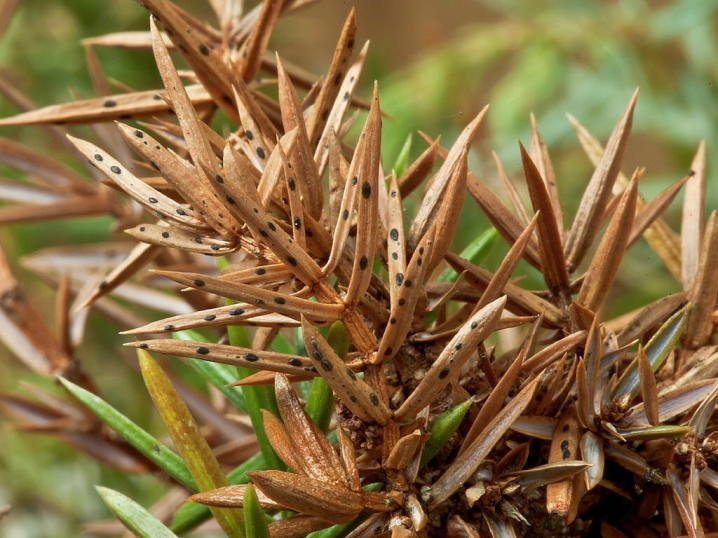
- Brown mold, or shute. The disease is also caused by pathogenic fungal microorganisms, while the juniper needles not only turn yellow, but also undergo gluing due to the presence of a gray cobweb. Sometimes the affected crown acquires a reddish tint, the most delicate thin shoots dry up, but the needles do not fall off. You can avoid infection by planting the juniper as spaciously as possible, avoiding excess water, cutting dry branches in time. 2 times a year for prevention, spraying with Bordeaux liquid is done.

- The plant can also dry out and turn yellow when damaged by rust, the causative agent is a basidiomycete fungus. During the year, it is difficult to notice that the juniper got sick, since the symptoms of the disease appear only in the second year - these are yellow neoplasms. Better to get rid of the diseased culture right away. Separate branches with growths must be removed, and in order to support the tree and increase its immunity, it is necessary to carry out treatment with an immunomodulator.
Often, conifer-gnawing and sucking pests become the culprits for the deterioration of the condition and appearance of the ephedra.
- When attacked by a spider mite a cobweb forms on the needles, dark spots, in addition, it turns yellow. After a while, the needles will begin to crumble. In order to prevent illness, it is necessary to moisten the crown of the juniper, and when a thin web appears, use insecticides in the form of plant infusions - dandelion or garlic. Colloidal sulfur helps a lot.
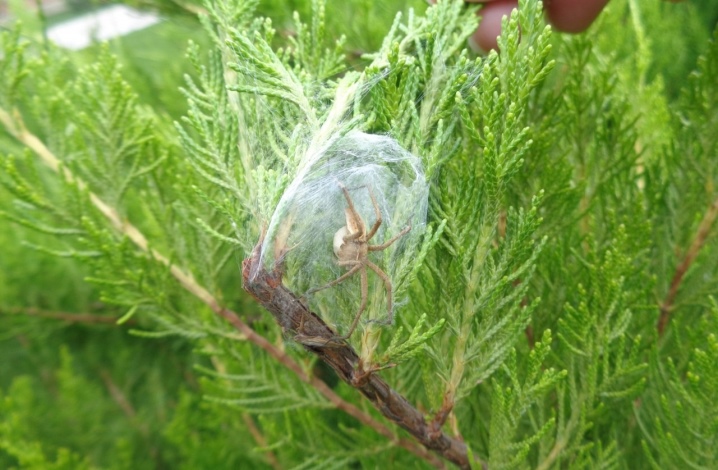
- Aphids pose a certain health hazard to ephedra. - the needles curl and turn yellow, the growth of branches is greatly slowed down. Aphids are eliminated with the help of insecticides, as well as washing branches and cutting off the most diseased shoots.

- Another enemy of various varieties of juniper is the mealybug. The insect settles in the cavities of the needles located on the lower branches. The presence of the worm leads to yellowing of the needles, and then it turns brown. It is quite difficult to fight the colony of this occupier, it is important to change the preparations so that the insect cannot adapt to them. According to gardeners, one of the most effective means is the combined insecticide "Engio".

Here are listed only the most common pests and fungal infections that can provoke yellow needles, but in fact there are other microorganisms whose activity leads to this result.
Therefore, when growing a crop, it is important to periodically carry out the prevention of any diseases.
Preventive measures
Constant care and preventive treatment of juniper will help prevent many diseases. But besides this, other procedures are also important, which reduce the risk of the appearance of diseases.
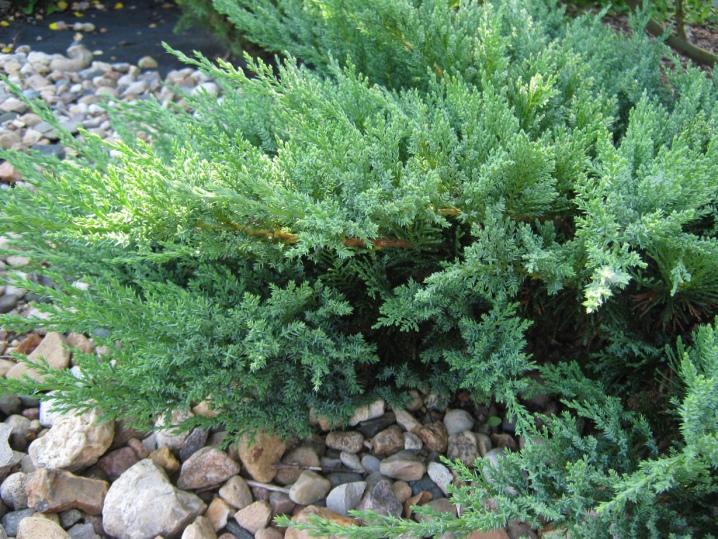
In order for the plant to remain healthy and have a beautiful appearance, you need to adhere to the rules for its maintenance.
- Necessary activities such as choosing a planting site, suitable soil for different types of crops, loosening, mulching and fertilizing must be timely.
- First of all, attention should be paid to the planting material, which must be fresh and healthy. If there are any suspicions about this, it is better to plant such seedlings separately from other already successfully grown plants.
- For any work - transplanting, pruning - any garden accessories, tools and containers must be thoroughly disinfected.
- Most plants of this species are affected by diseases due to the high acidity of the soil, with the exception of a few shrubs that prefer an acidic composition. This means that it is necessary to take care of the introduction of lime into the soil in advance.
- The immunity and viability of the main organ - the root, largely depends on the timely treatment with immunomodulatory agents.Judging by the gardeners' reviews, the most effective drugs that promote the formation and activity of the root system are the siliplant chelated microfertilizer and the concentrated growth biostimulator Super Humisol, which regulates the basic vital processes of the juniper. You can use a unique growth stimulator "Epin extra" or biofertilizer made by cultivating microorganisms - "Nikfan".
- Do not forget about seasonal fertilizers, which play an important role in the state of the culture. If the soil is fed in spring, autumn, and, if necessary, in summer with the necessary minerals, this will ensure normal nutrition of the roots and the aerial part and reduce the threat of infection.
- Insects found on the branches and bark must be eliminated immediately, without waiting for their reproduction - a large number of pests most often causes irreversible damage and death of the ephedra. Therefore, two or more use of strong insecticides will be required. As for prevention, the best way to protect the bushes is to mulch their near-trunk space with pine bark.
- After winter, juniper trees in the country often turn yellow, and this is not always the so-called physiological dryness due to frozen soil and lack of moisture. The larvae of some pests are capable of hibernating on the crop, therefore, at the very beginning of spring, it is necessary to set traps for caterpillars, and carry out a sanitary shearing of the affected branches.

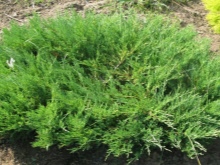
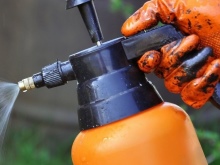
It must be remembered that poorly drained soil, too close planting of bushes, lack of lighting, and the presence of weeds can become a prerequisite for the disease.
Infection with pests and infections does not occur if the conditions for growing the juniper are favorable. In most cases, the causes of diseases are violations of the requirements for agricultural technology and the gardener's own mistakes.
For diseases and pests of juniper, see below.



































































The comment was sent successfully.